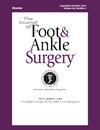足部骨折开放或封闭治疗的结果:一项比较糖尿病患者和非糖尿病患者的数据库研究。
IF 1.3
4区 医学
Q2 Medicine
引用次数: 0
摘要
糖尿病患者踝关节和足部骨折的治疗具有挑战性,并且可能出现并发症。虽然有很多关于胫骨、腓骨和踝骨折并发症发生率的资料,但关于跗骨、跖骨和足指骨骨折并发症发生率的资料却相当缺乏。因此,我们的目的是比较糖尿病和非糖尿病患者骨折后的术后结果。使用ICD-10代码检索2010 - 2023年跟骨、长方体、舟骨、距骨、楔形骨、跖骨和指骨骨折患者的开放或闭合手术治疗的市售去识别数据库。术后随访至少1年的患者纳入研究。然后我们将患者分为两组:糖尿病患者(108,603,26.4%)和非糖尿病患者(302,464,73.6%)。评估术后并发症,包括手术治疗时与硬体相关的并发症(再手术、不愈合、不愈合、延迟愈合、伤口破裂、手术部位感染)和骨折治疗后的健康并发症(AKI、DVT、心肌梗死、肺炎、败血症),并使用优势比比较糖尿病患者与非糖尿病患者每根骨的这些并发症的发生率。与非糖尿病患者相比,糖尿病患者骨折治疗后所有骨骼的并发症发生率明显更高。临床证据等级:3。本文章由计算机程序翻译,如有差异,请以英文原文为准。
Outcomes of open or closed treatment of foot fractures: A database study comparing patients with and without diabetes
Treatment of ankle and foot fractures in patients with diabetes mellitus (DM) is challenging, and complications may arise. Although much data exists on complication rates in tibial, fibular, and malleolar fractures, there exists a comparable lack of data on complication rates in fractures of the tarsal, metatarsal, and phalanx bones of the foot. Therefore, we aimed to compare post-procedural outcomes after such fractures in diabetic vs non-diabetic patients. A commercially available de-identified database was searched using ICD-10 codes for the open or closed surgical treatment in patients with fractures of the calcaneus, cuboid, navicular, talus, cuneiforms, metatarsals, and phalanges from 2010 to 2023. Patients with at least 1 year of post-procedural follow-up were included. We then separated patients into two groups: those with diabetes (108,603, 26.4 %) and those without diabetes (302,464, 73.6 %).
Post-procedural complications assessed including those related to hardware when surgical treatment was pursued (reoperation, non-union, malunion, delayed union, wound disruption, surgical site infection) and health complications after fracture treatment (AKI, DVT, MI, pneumonia, sepsis) were assessed at 1 year and odds ratios were used to compare rates of these complications in diabetics vs non-diabetics for each bone. Rates of complications after fracture treatment were found to be significantly higher in all bones for diabetic patients compared to non-diabetic patients.
求助全文
通过发布文献求助,成功后即可免费获取论文全文。
去求助
来源期刊

Journal of Foot & Ankle Surgery
ORTHOPEDICS-SURGERY
CiteScore
2.30
自引率
7.70%
发文量
234
审稿时长
29.8 weeks
期刊介绍:
The Journal of Foot & Ankle Surgery is the leading source for original, clinically-focused articles on the surgical and medical management of the foot and ankle. Each bi-monthly, peer-reviewed issue addresses relevant topics to the profession, such as: adult reconstruction of the forefoot; adult reconstruction of the hindfoot and ankle; diabetes; medicine/rheumatology; pediatrics; research; sports medicine; trauma; and tumors.
 求助内容:
求助内容: 应助结果提醒方式:
应助结果提醒方式:


